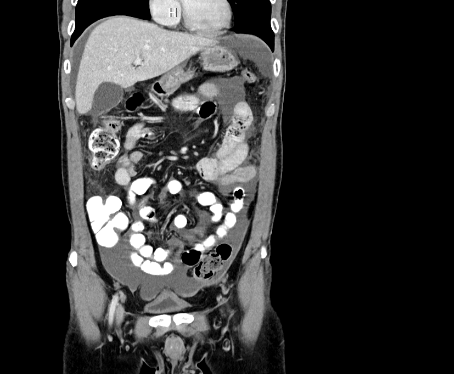Monday Poster Session
Category: Infections and Microbiome
P3481 - An Unusual Cause of Abdominal Pain: A Rare Case of Fungal Infection of the Omentum in an Immunocompetent Patient
Monday, October 27, 2025
10:30 AM - 4:00 PM PDT
Location: Exhibit Hall

Kyle Schneider, DO
Creighton University
Chandler, AZ
Presenting Author(s)
Kyle Schneider, DO, Shamiram Benjamin, MD, MBA, Armaan Mullick, , Shaan Mullick, , Brooke Wilson, NP, Tarun Mullick, MD
Creighton University, Chandler, AZ
Introduction: Coccidioidomycosis, a dimorphic fungi endemic to the Southwest USA/Mexico, is a mycosis primarily affecting the lungs particularly those who are residing or working near affected areas with disruption of the soil. Extrapulmonary dissemination occurs in a minority of cases, typically in immunocompromised hosts involving the skin, bones, joints, and CNS. Intra-abdominal manifestations are exceedingly rare, with omental involvement representing an unusual and diagnostically challenging presentation as in this case.
Case Description/
Methods: A 48M with PMH umbilical hernia presented with umbilical pain, weight loss, early satiety and new onset constipation. CT abd. scan revealed umbilical hernia, with diffuse nodularity of the omentum concerning for possible peritonitis vs. peritoneal carcinomatosis. CBC, CMP, INR, AFP, acute hepatitis panel all normal. Oncology consulted for workup of potential primary vs metastatic malignancy. Tumor markers and CT guided peritoneal biopsy ordered. Tumor markers returned normal result Cocci titers were ordered. Biopsy results ultimately returned “fibrous connective tissue with granulomatous inflammation including non-caseating granulomas. Rare fungal like debris suggestive of Coccidioides.”
Discussion: The evaluation of vague abdominal pain often involves a broad differential with malignancy an urgent concern when imaging reveals nodules or masses. In this case, the patient presented with persistent lower abdominal pain without systemic signs of infection. Initial laboratory investigations were unremarkable, contributing to diagnostic ambiguity. Cross-sectional imaging did reveal omental nodularity raising concern for primary vs metastatic malignancy. Biopsies were ultimately pursued, with Histopathology demonstrating granulomatous inflammation consistent with Coccidioides species. The rarity of isolated omental involvement, particularly in an immunocompetent host, posed a significant diagnostic challenge. The absence of pulmonary symptoms further complicated the clinical picture, delaying consideration of coccidioidomycosis in the differential at initial presentation. This case highlights the importance of considering endemic fungal infections in atypical presentations and reinforces the diagnostic value of tissue biopsy in unexplained intra-abdominal nodules.

Figure: Omental Nodularity
Disclosures:
Kyle Schneider indicated no relevant financial relationships.
Shamiram Benjamin indicated no relevant financial relationships.
Armaan Mullick indicated no relevant financial relationships.
Shaan Mullick indicated no relevant financial relationships.
Brooke Wilson indicated no relevant financial relationships.
Tarun Mullick indicated no relevant financial relationships.
Kyle Schneider, DO, Shamiram Benjamin, MD, MBA, Armaan Mullick, , Shaan Mullick, , Brooke Wilson, NP, Tarun Mullick, MD. P3481 - An Unusual Cause of Abdominal Pain: A Rare Case of Fungal Infection of the Omentum in an Immunocompetent Patient, ACG 2025 Annual Scientific Meeting Abstracts. Phoenix, AZ: American College of Gastroenterology.
Creighton University, Chandler, AZ
Introduction: Coccidioidomycosis, a dimorphic fungi endemic to the Southwest USA/Mexico, is a mycosis primarily affecting the lungs particularly those who are residing or working near affected areas with disruption of the soil. Extrapulmonary dissemination occurs in a minority of cases, typically in immunocompromised hosts involving the skin, bones, joints, and CNS. Intra-abdominal manifestations are exceedingly rare, with omental involvement representing an unusual and diagnostically challenging presentation as in this case.
Case Description/
Methods: A 48M with PMH umbilical hernia presented with umbilical pain, weight loss, early satiety and new onset constipation. CT abd. scan revealed umbilical hernia, with diffuse nodularity of the omentum concerning for possible peritonitis vs. peritoneal carcinomatosis. CBC, CMP, INR, AFP, acute hepatitis panel all normal. Oncology consulted for workup of potential primary vs metastatic malignancy. Tumor markers and CT guided peritoneal biopsy ordered. Tumor markers returned normal result Cocci titers were ordered. Biopsy results ultimately returned “fibrous connective tissue with granulomatous inflammation including non-caseating granulomas. Rare fungal like debris suggestive of Coccidioides.”
Discussion: The evaluation of vague abdominal pain often involves a broad differential with malignancy an urgent concern when imaging reveals nodules or masses. In this case, the patient presented with persistent lower abdominal pain without systemic signs of infection. Initial laboratory investigations were unremarkable, contributing to diagnostic ambiguity. Cross-sectional imaging did reveal omental nodularity raising concern for primary vs metastatic malignancy. Biopsies were ultimately pursued, with Histopathology demonstrating granulomatous inflammation consistent with Coccidioides species. The rarity of isolated omental involvement, particularly in an immunocompetent host, posed a significant diagnostic challenge. The absence of pulmonary symptoms further complicated the clinical picture, delaying consideration of coccidioidomycosis in the differential at initial presentation. This case highlights the importance of considering endemic fungal infections in atypical presentations and reinforces the diagnostic value of tissue biopsy in unexplained intra-abdominal nodules.

Figure: Omental Nodularity
Disclosures:
Kyle Schneider indicated no relevant financial relationships.
Shamiram Benjamin indicated no relevant financial relationships.
Armaan Mullick indicated no relevant financial relationships.
Shaan Mullick indicated no relevant financial relationships.
Brooke Wilson indicated no relevant financial relationships.
Tarun Mullick indicated no relevant financial relationships.
Kyle Schneider, DO, Shamiram Benjamin, MD, MBA, Armaan Mullick, , Shaan Mullick, , Brooke Wilson, NP, Tarun Mullick, MD. P3481 - An Unusual Cause of Abdominal Pain: A Rare Case of Fungal Infection of the Omentum in an Immunocompetent Patient, ACG 2025 Annual Scientific Meeting Abstracts. Phoenix, AZ: American College of Gastroenterology.
